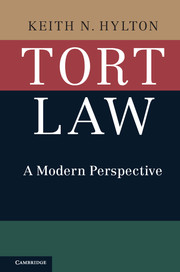Book contents
- Frontmatter
- Contents
- 1 Introduction
- 2 Policy and Tort Law
- 3 Evolution of Tort Law
- 4 Intentional Torts
- 5 Theoretical Foundations of Strict Liability
- 6 The Reasonable Person
- 7 Customs, Statutes, and the Reasonable Person
- 8 Inferring Negligence
- 9 Contributory Negligence and Assumption of Risk
- 10 Contributory Negligence, Comparative Negligence, and Incentives for Care
- 11 Joint and Several Liability, and Vicarious Liability
- 12 Factual Causation
- 13 Proximate Cause
- 14 Duty to Rescue and Special Relationships
- 15 Strict Liability: Conversion, Abnormally Dangerous Activities, and Nuisance
- 16 Defamation
- 17 Products Liability
- 18 Damages
- Index
15 - Strict Liability: Conversion, Abnormally Dangerous Activities, and Nuisance
Published online by Cambridge University Press: 05 June 2016
- Frontmatter
- Contents
- 1 Introduction
- 2 Policy and Tort Law
- 3 Evolution of Tort Law
- 4 Intentional Torts
- 5 Theoretical Foundations of Strict Liability
- 6 The Reasonable Person
- 7 Customs, Statutes, and the Reasonable Person
- 8 Inferring Negligence
- 9 Contributory Negligence and Assumption of Risk
- 10 Contributory Negligence, Comparative Negligence, and Incentives for Care
- 11 Joint and Several Liability, and Vicarious Liability
- 12 Factual Causation
- 13 Proximate Cause
- 14 Duty to Rescue and Special Relationships
- 15 Strict Liability: Conversion, Abnormally Dangerous Activities, and Nuisance
- 16 Defamation
- 17 Products Liability
- 18 Damages
- Index
Summary
Two sources of strict liability evolved early in the common law: trespass and Rylands v. Fletcher. Liability under trespass law is strict in the sense that the plaintiff does not have to prove fault on the part of the defendant. In a trespass action, the facts need only show that the defendant was aware of what he was doing when he interfered with the plaintiff's exclusive right of possession.
Similarly, the Rylands strict liability doctrine does not require the plaintiff to prove fault on the part of the defendant. The defendant will be held liable under Rylands if he keeps something on his property that escapes without the plaintiff's fault and causes harm, provided that certain conditions determining the unreasonableness of the defendant's activity are satisfied. Those conditions were examined in Chapter 5 and are reexamined in much greater detail here.
While Chapters 4 and 5 developed functionalist accounts of trespass and Rylands liability, this chapter will extend those perspectives to the doctrines of conversion, abnormally dangerous activities, and nuisance. Conversion is an offshoot of trespass, whereas abnormally dangerous activities and nuisance are offshoots of Rylands.
TRESPASS-BASED STRICT LIABILITY
The major categories of trespass-based strict liability are trespass to real property, trespass to chattels (personal property), and conversion. The law across these categories is consistent.
Trespass is the intentional interference with exclusive possession of real property. A trespass claim can be brought against the interfering party by the owner of the property or by someone who has a right to possess the property. Interference means ousting or physically displacing the plaintiff from some space on his land, as occurs when the defendant physically occupies the space or sends some object, such as a rock, over to the plaintiff's land (Chapter 4). The law defines this interference on the basis of visual cues, not science. One could argue that on a sufficiently small scale of measurement, at the molecular or atomic level, the plaintiff's exclusive possession has been invaded when the defendant's cigarette smoke wafts across the property boundary to the plaintiff's land. But this type of invasion generally has not been recognized as a trespass.
- Type
- Chapter
- Information
- Tort LawA Modern Perspective, pp. 271 - 300Publisher: Cambridge University PressPrint publication year: 2016



